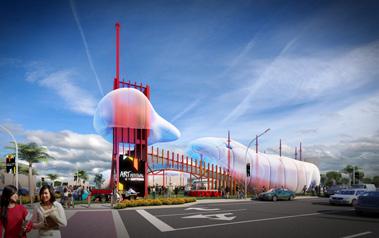
3 minute read
CHANGING SETTINGS CHANGING PURPOSE: BUILDING FLEXIBILITY THROUGH MOVABLE ELEMENTS
By Enzo Marfella
As nature responds organically to its environment, architecture can adapt to its context and programmatic needs while fueling memorable experiences that energize the human senses. Today more than ever, the ideas of transformation and movement can strengthen our work patterns and provide flexibility, adaptability, and resilience in the workplace through the movement of architectural elements.
Problem solving for a variety of program types and uses through movable and adaptable architecture was evident before COVID-19 and our new normal. Several excellent examples range from James Sterling’s Olivetti Training Center with its occupant-regulated, sliding balcony roofs, to REX – OMA’s AT&T Performing Arts Center Dee & Charles Wyly Theater with sectionally rotating stage configurations that unlock creativity and endless possibilities for different stage settings.

James Sterling’s Olivetti Training Center

REX – OMA’s AT&T Performing Arts Center Dee & Charles Wyly Theater
Today’s workplace needs to become an ever changing stage of inventive inspiration and endless possibilities while fueling creativity and innovation through these movable design solutions. Adjacent parking lots can become pop-up community gathering spaces, offices can become workshops and plazas can become outdoor stadiums. The natural human need to control surroundings allows users to feel empowered by the ability to manipulate their settings to respond to individual needs. Like the best examples in nature, these transformations expand and reconfigure to provide instinctual experiences of prospect – the ability to view the situation and engage with nearby activity – and refuge – the ability to withdraw to a quiet, more protected place. The modern workplace has created flexible work settings to respond to the immediate needs of workers based on the task that they’re engaged in, and the COVID-19 pandemic gives us yet another reason for these changeable spaces.

Air Portable Popup Park Concept
Kinetic - or kinetic - solutions can bridge the gap between how we used to work and how we will need to work post COVID-19. As the office remains the preferred location for people to work, allowing for a variety of uses in spaces can minimize the amount of real estate needed while meeting the anticipated new requirements of social distancing and staggered workforce reentry. Often underutilized entry lobbies can become multi-functional, allowing the office trip to accommodate the home and work life balance as a new kind of work setting. Operable doors to entry plazas can add another dimension of wellness to the experience by exposing workers to nature and the positive benefits of a biophilic ‘bump’, reducing stress hormones and blood pressure, and further extending the workplace.
Finding new uses for conventional space will maximize utilization: circulation within an office layout can widen and accommodate ‘plug and work’ touch down spaces creating distanced collaboration pockets. With work shifts happening, the need for a centralized hub of large equipment to support a smaller work from home setting can strengthen this dynamic. Printer / copy / supply rooms can be redesigned as workspace, with equipment folding into walls through movable millwork. Operable wall panels can continue to provide flexibility for large spaces, while spacing of workstations can be changed through sliding stations on floor tracks, reconfiguring the number of personal workspaces and the distance between them.

Little's Charlotte Office

Finastra Corporate Headquarters
With technology at the forefront of our new normal, kinetic architecture and its direct connection to the human experience can provide a much-needed balance. The workplace is moving toward informality and adaptability, and mechanically activated building elements will play an integral role in adapting architecture to its environment. Building facades will advance their responses to the movement of the sun with automated precision, building skins will filter out environmental contaminants, and interior environments will allow the reconfigure of their proportion and attributes to changing needs and a culture thirsty for inspiration and meaning. The very fabric of architecture, once static and immobile, is becoming a transformative mechanism of responsive adaptation. As the environment and our new normal changes, so too does architecture and its impact on its inhabitants.

Enzo Marfella, AIA, is a Design Principal in the Workplace Practice at Little and can be reached at enzo.marfella@littleonline.com








